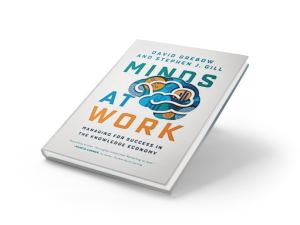 One of the most widely read of my recent posts was The Pizza Story about the artisanal pizza made by robots in the Zume pizzeria in Palo Alto, California. The post showed that we have no idea how far automation has already reached its steely fingers into the many places in our lives. The point was to prove how far and how fast we are moving away from the industrial model of management and learning that focused on managing hands. We are rapidly approaching a time when almost all work will be performed either partly or completely by people’s minds, and we will need to discover how to manage minds and provide ways for them to learn and grow.
One of the most widely read of my recent posts was The Pizza Story about the artisanal pizza made by robots in the Zume pizzeria in Palo Alto, California. The post showed that we have no idea how far automation has already reached its steely fingers into the many places in our lives. The point was to prove how far and how fast we are moving away from the industrial model of management and learning that focused on managing hands. We are rapidly approaching a time when almost all work will be performed either partly or completely by people’s minds, and we will need to discover how to manage minds and provide ways for them to learn and grow.
I loved this article in a recent issue of The Atlantic Monthly because of what happened to Freedom Carlson. Without a high school degree, let alone a college diploma to insulate her from the transition to managing minds, she was promoted from kitchen helper working alongside the robots to “culinary-program administrator”. She is learning coding and how to use the software that determines the nutritional facts for a pizza you order from Zume. She is a great example of how we can revise our old industrial era ideas about management and learning and move from managing hands to managing minds. The key is believing that people have a growth mindset that enables them to learn and providing the knowledge they need to grow.
Here’s the piece that appeared in The Atlantic Magazine:
“Less dystopian was the scene at Zume Pizza, in Mountain View, California, where I watched an assembly line of robots spread sauce on dough and lift pies into the oven. Thanks to its early investment in automation, Zume spends only 10 percent of its budget on labor, compared with 25 percent at a typical restaurant operation. The humans it does employ are given above-average wages and perks: Pay starts at $15 an hour and comes with full benefits; Zume also offers tuition reimbursement and tutoring in coding and data science. I talked with a worker named Freedom Carlson, who doesn’t have a college degree. She started in the kitchen, where she toiled alongside the robots. She has since been promoted to culinary-program administrator, and is learning to navigate the software that calculates nutritional facts for Zume pizzas.”
What struck me as instructive was the way the savings in labor costs – down to 10% from the standard 25% – was reinvested into the workers including
- above-average wages – starting at $15 an hour
- full benefits – health, vacation, and sick time
- tuition reimbursement – this was what I loved that included tutoring in coding and data science.
The article goes on to point out something too often overlooked when we talk about the impact of automation on the workforce. We need to focus on people’s minds and their ability to learn new technological skills, regardless of their level of educational attainment. It also makes a key point: We need progressive employers – with the help of a progressive government – to provide that learning and make it happen.
“This has typically been the story of automation: Technology obviates old jobs, but it also creates new ones—the job title radiology technician, for example, has been included in census data only since 1990. Transitioning to a new type of work is never easy, however, and it might be particularly difficult for many in the service sector. New jobs that arise after a technological upheaval tend to require skills that laid-off workers don’t have, and not all employers will be nearly as progressive as Zume. A college education helps insulate workers from automation, enabling them to develop the kind of expertise, judgment, and problem-solving abilities that robots can’t match. Yet nearly 80 percent of workers in food preparation and service-related occupations have a high-school diploma or less, according to the Bureau of Labor Statistics.”
Minds at Work is a groundbreaking and carefully-researched explanation about why our ideas about management and learning are more than 100 years out-of-date and need to be revised. The book is published by ATD Press and is available in paperback and ebook versions on ATD Press and Amazon. The ATD Press site also has a free Executive Summary and Sample Chapter.
